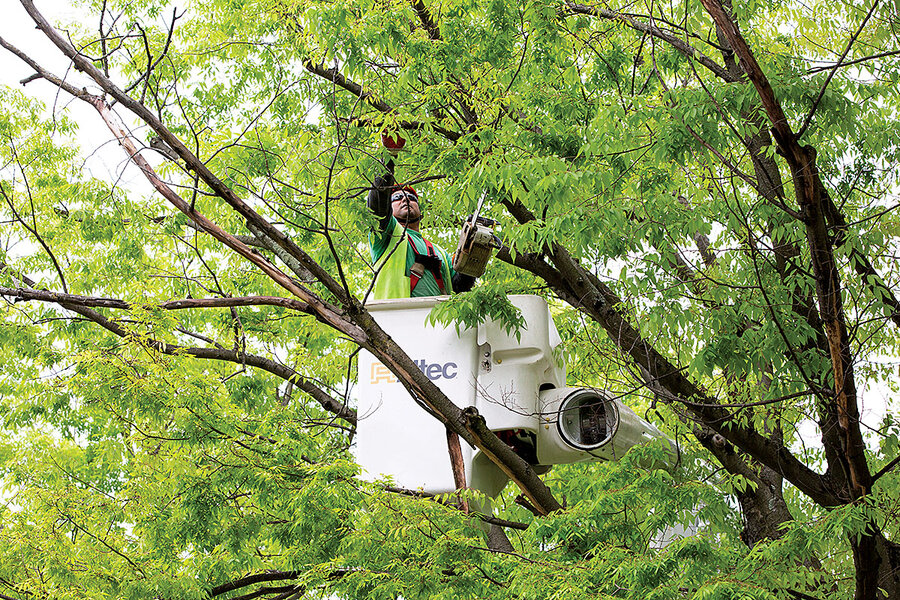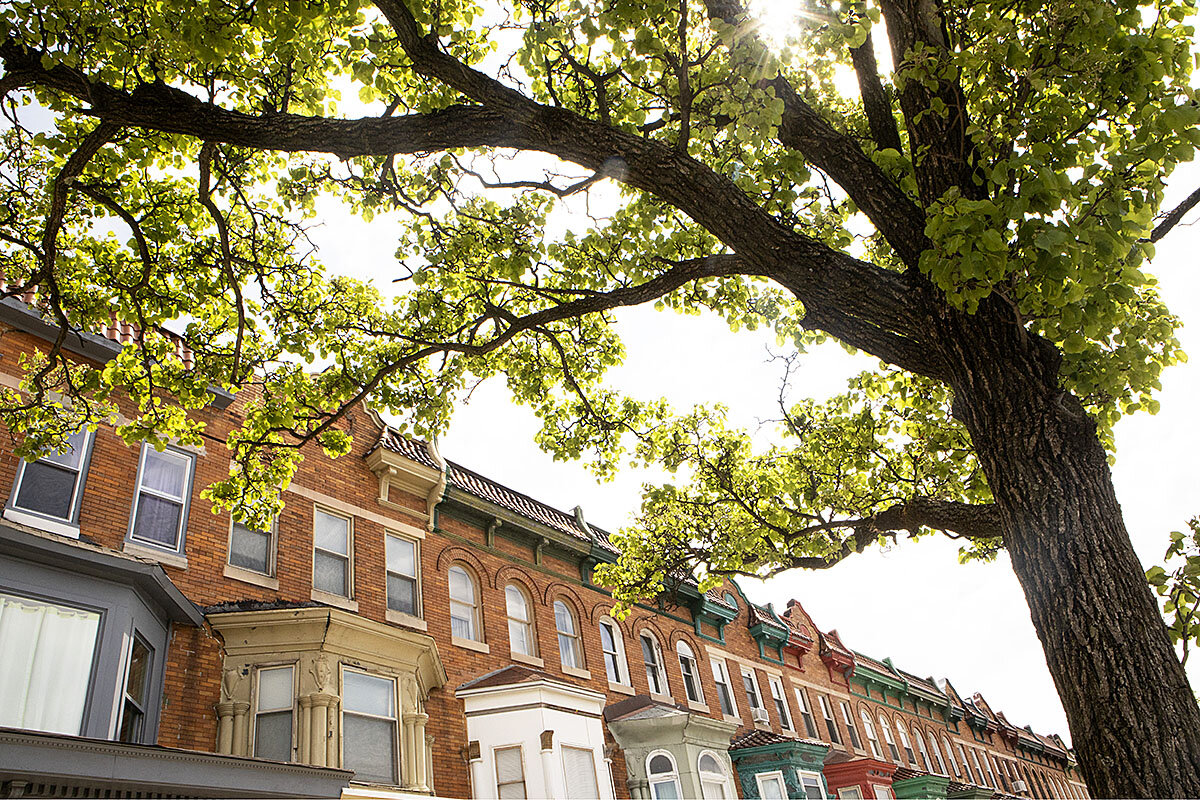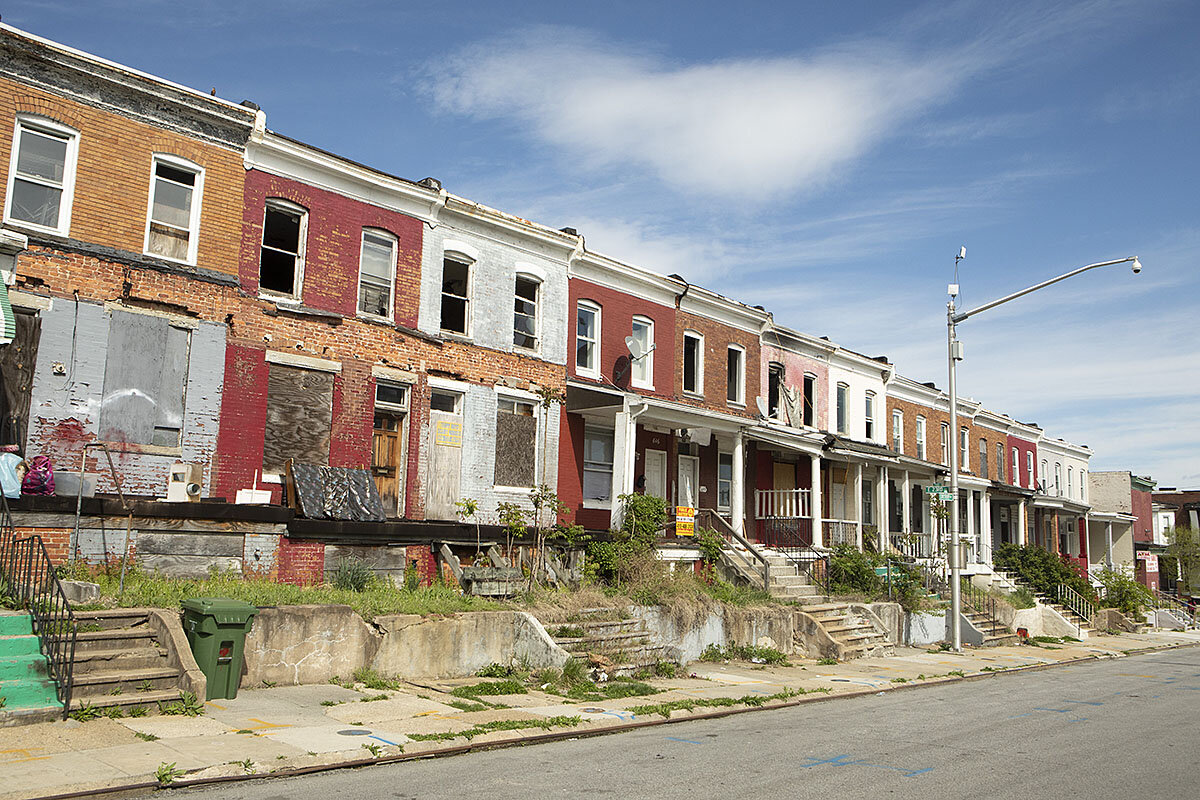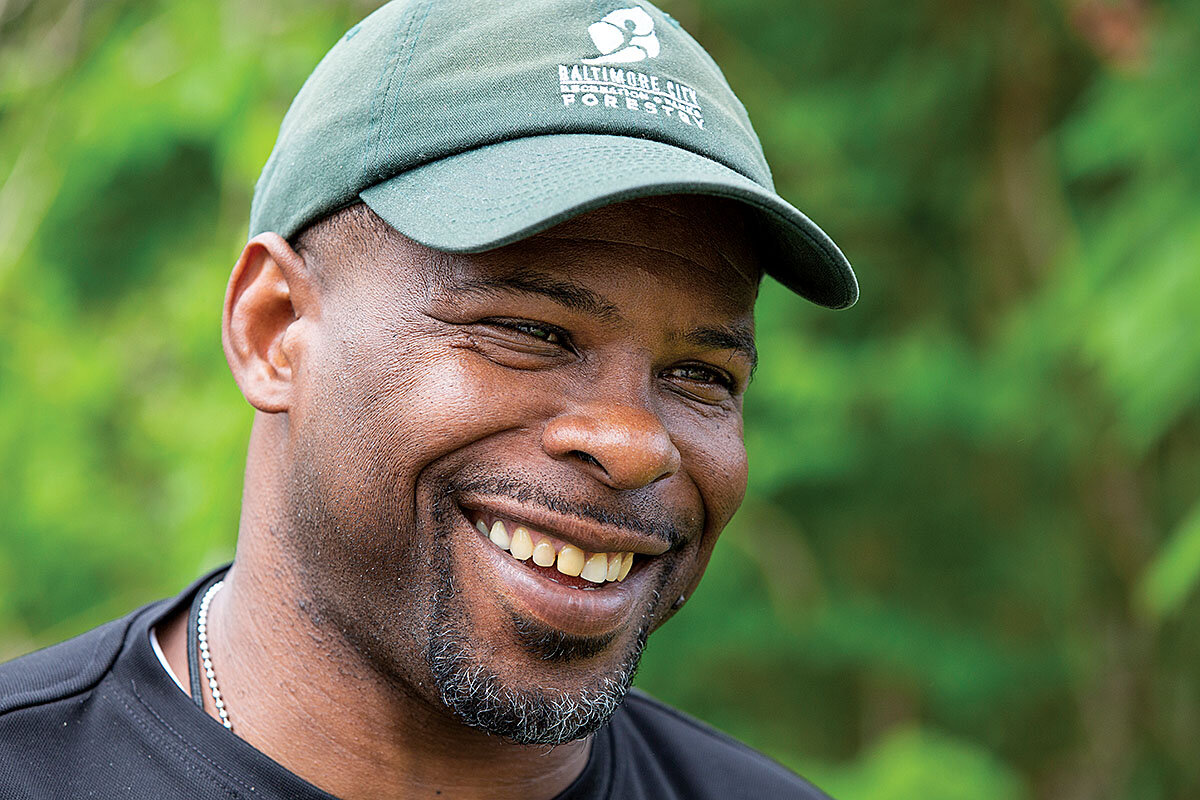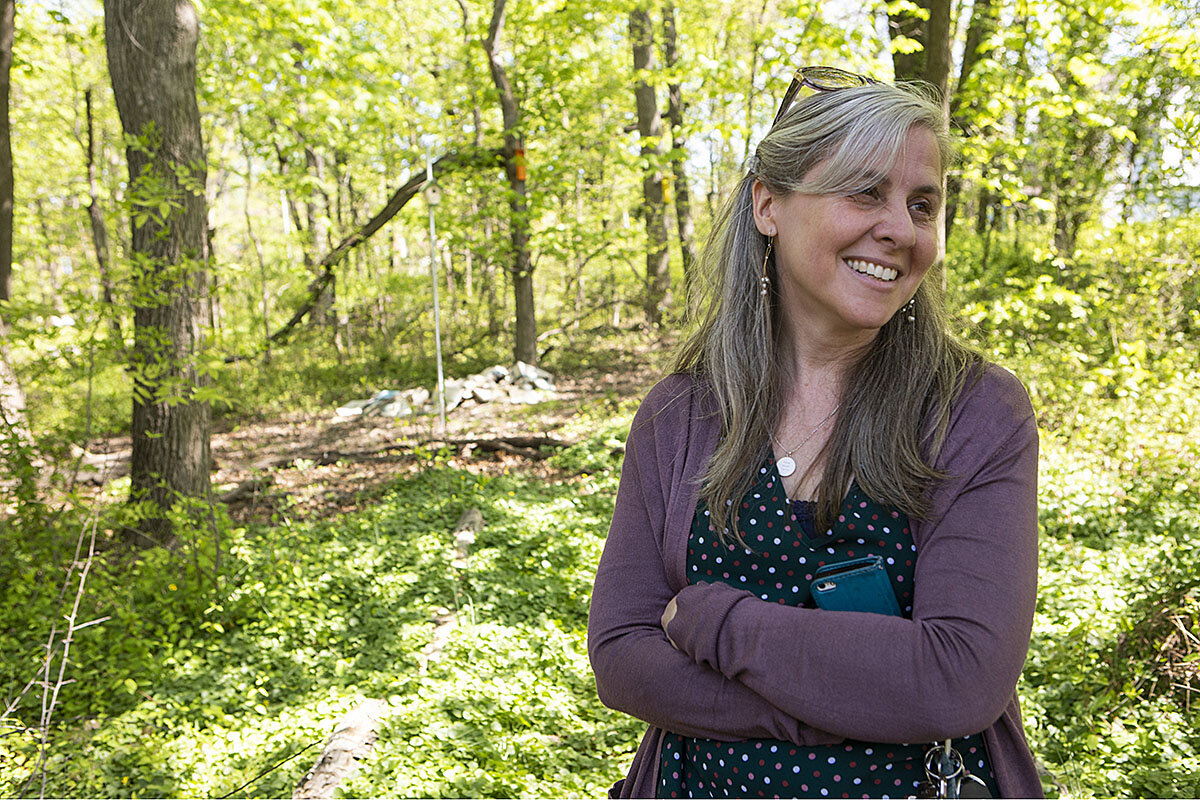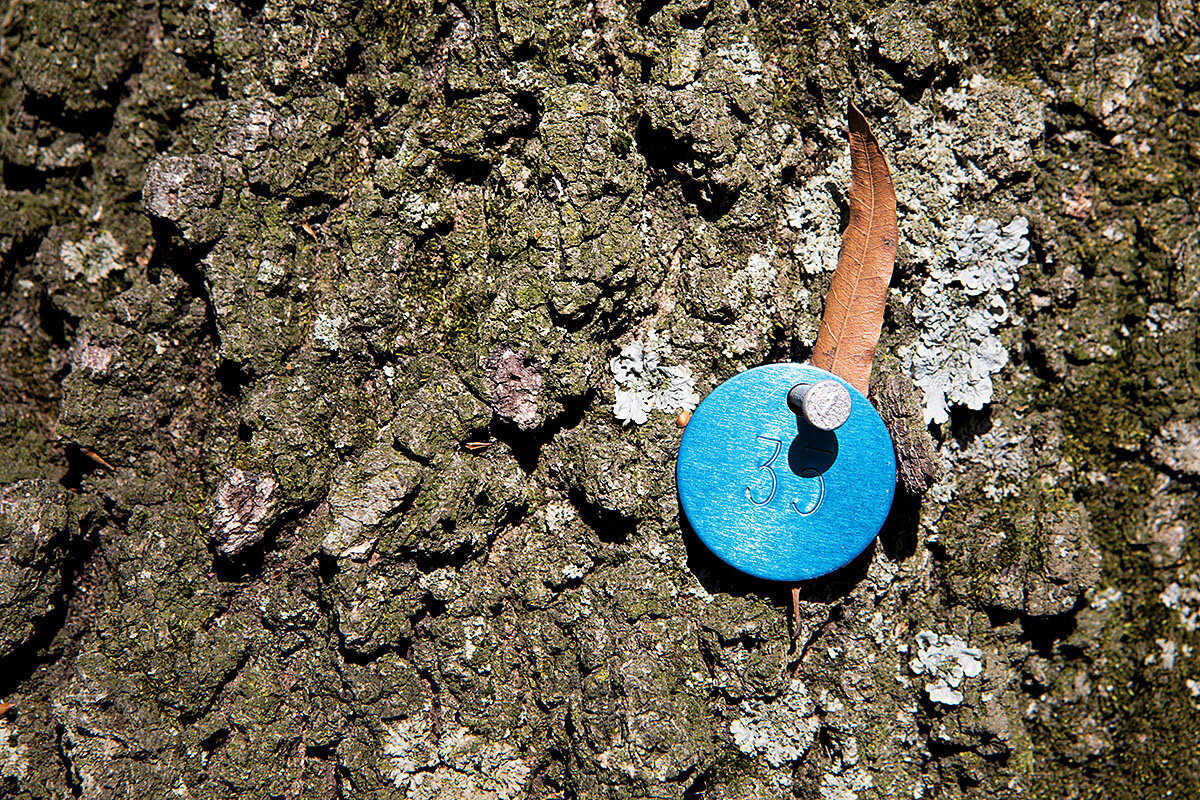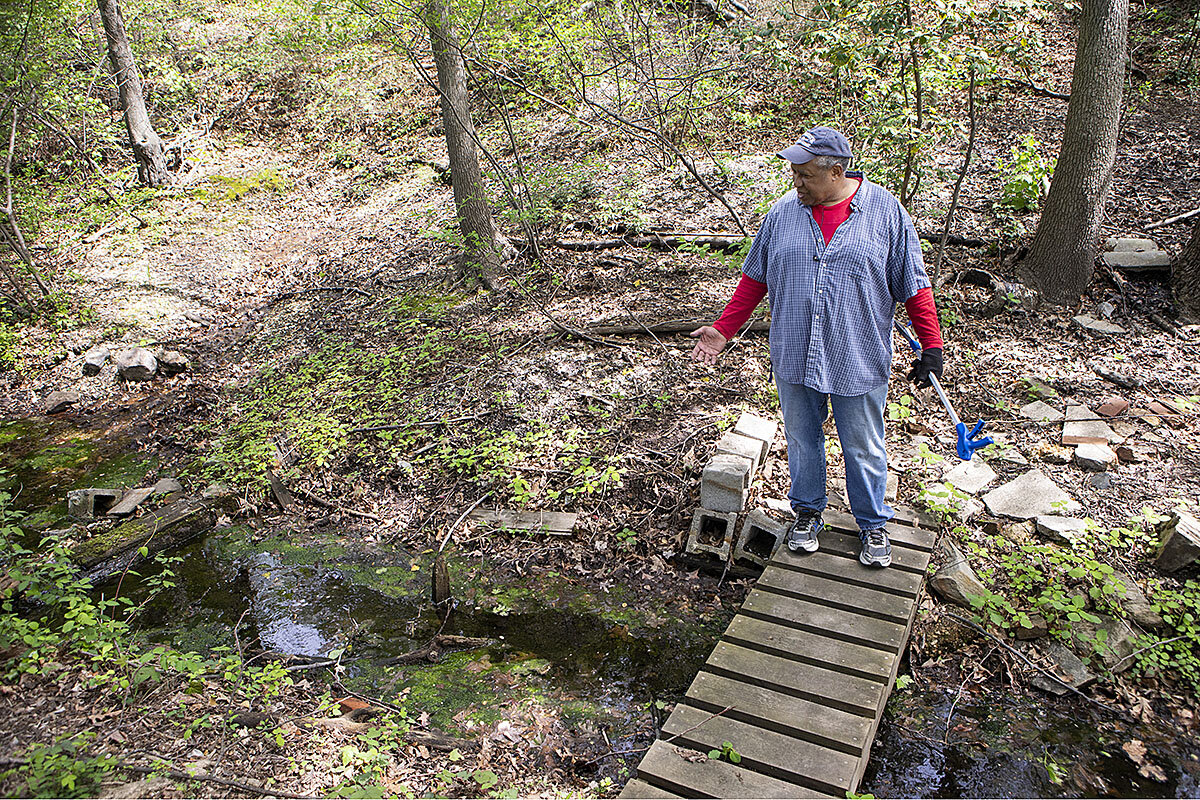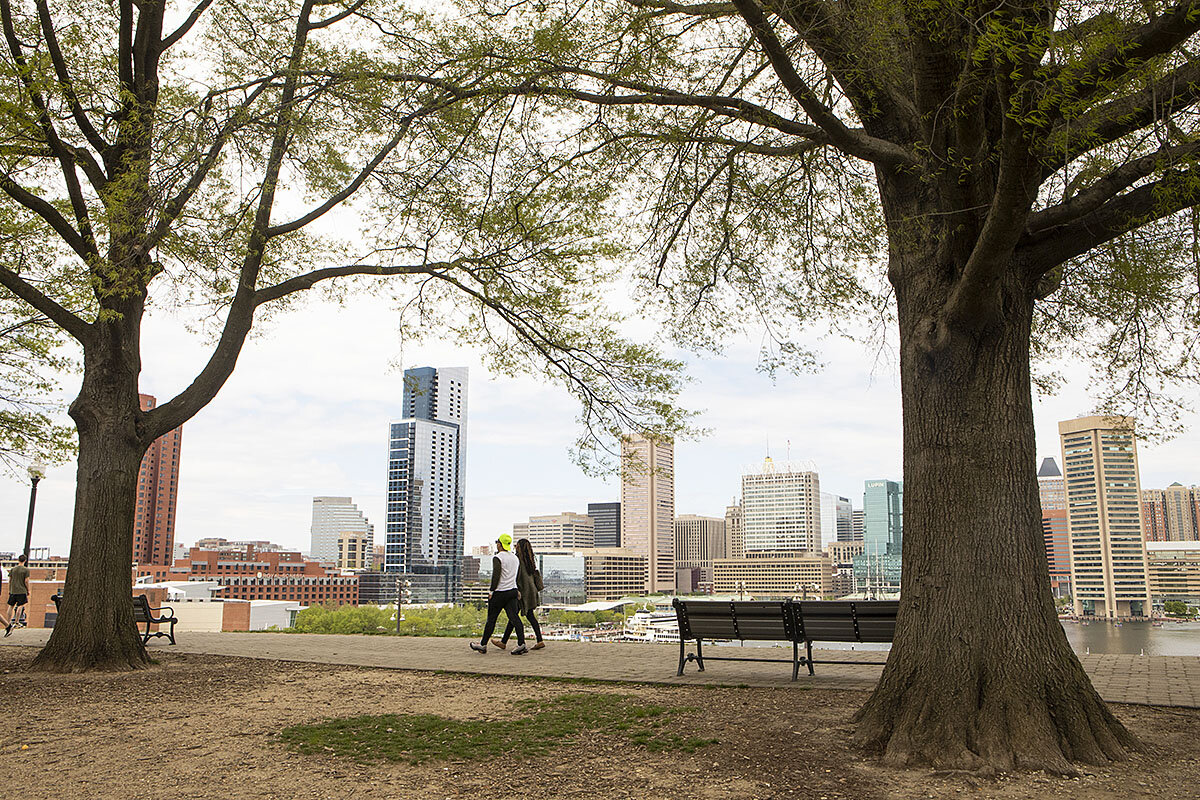How Baltimore is saving urban forests – and its city
Loading...
| Baltimore
From his headquarters office, Erik Dihle drives into what has become one of the most monitored forests in the United States.
He begins to point out the trees: There is a tulip poplar, as big as the ones George Washington planted at Mount Vernon. There are the blossoming cherries, with a cotton-candy display that rivals their famous compatriots down the road at the Tidal Basin in Washington, D.C. And there is a white oak, Maryland’s state tree, with its branches gnarling horizontally for yards.
“This is a good-size one,” he says, getting out of his truck to pace the area of shade created by the tree’s canopy. “I’d be surprised if it was less than 150 years old.”
Why We Wrote This
The words “city” and “forest” don’t usually go together. But urban forests can bring striking benefits, from lower crime rates to higher home values.
A few blocks away, someone lays on a horn, and traffic begins to move along one of this city’s main arteries. Construction vehicles beep as they repair an old municipal reservoir. And Mr. Dihle jumps back into his truck, ready to show more trees.
Mr. Dihle’s forest is in the city. He is the arborist and the head of forestry for the city of Baltimore, which means he monitors all the trees here – those growing in shady parks, in metal grates along busy streets, in backyards, and in relatively untouched forest patches dotting the municipality. Together, these trees make up what is called the city’s “urban forest,” a type of ecosystem that is gaining attention at both the national and international levels among everyone from environmentalists to politicians, social justice advocates to corporations.
With concern growing about climate change and rapid worldwide urbanization, city forests have emerged as one widely touted solution to a host of social and environmental challenges. Municipalities from Barcelona, Spain; to Melbourne, Australia; to Chicago have put urban canopy coverage at the center of their long-term strategic plans. Community groups focusing on planting, maintaining, and saving trees have blossomed across the U.S. In 2015, the World Economic Forum’s Global Agenda Council on the Future of Cities named increasing green canopy coverage as one of its top 10 urban initiatives.
Yet at the same time, the U.S. Forest Service, which in the past decade has also upped its focus on urban forests, has found that American cities are losing trees – and quickly.
A Forest Service report published last year found that across the U.S., populated areas lost about 175,000 acres of trees per year between 2009 and 2014, or approximately 36 million trees per year. Forty-five states had a net decline in tree cover in these areas, with 23 of those states experiencing significant decreases. Meanwhile, urban regions showed a particular decline, along with an increase in what the researchers call “impervious surfaces” – in other words, concrete.
But not, it turns out, in Baltimore.
Here, the net tree canopy coverage has increased. Not by a lot, Mr. Dihle is quick to point out – only from 27% of the city’s land coverage to 28% – and not because Baltimore hasn’t lost trees. It has. But overall the tree canopy here has grown, which means that Mr. Dihle has found himself presiding over one of the more successful efforts in the U.S. to preserve and improve the urban forest.
It’s become an improbable green model for cities around the world.
The intersection of trees and urban living
Trees have been in cities, of course, for centuries. Documents from early New England settlements include rules and regulations about how residents should make use of trees growing on town commons. Many municipalities appointed tree wardens to make sure everyone followed the law. Even the modern concept of urban forestry has been around since the 1960s, when officials in the Johnson administration looked toward nature, and trees in particular, to help revitalize urban landscapes that they perceived to be crumbling.
But in recent years, scientists say, demographic trends have shifted attention toward the urban forest in a new way.
Across the world, there is a rapid and increasing movement of people from rural areas to cities. In 2009, the United Nations estimated that 3 million people worldwide moved to a city every week. By 2015 more than half of the world’s population lived in urban areas, according to the U.N., with the number of city dwellers expected to grow from 3.9 billion to 6.7 billion by 2050.
The same is true in the U.S. More than 80% of Americans live in urban areas, even though cities account for only 3.6% of the country’s landmass.
At the same time, new technology has let researchers better understand the urban ecosystem – not just how trees thrive or fail in a city, but how they intersect with humans.
“They impact work productivity, wildlife habitats, air pollution removal, carbon sequestration, energy use,” says David Nowak, senior scientist with the U.S. Forest Service who authored the recent national report on tree canopy loss. “We might as well work with the forests. Nature is giving us this amazing resource. ... We should be smart about this whole process and use nature to make our lives better.”
Much of the understanding of how, exactly, trees affect everything from climate to criminal justice stems from a technological breakthrough pioneered in Baltimore.
For decades, scientists recorded their data on paper, filling notebooks and filing cabinets. With the advent of computers, foresters were able to tabulate and analyze the information in a new way. By the 1990s, satellite imagery allowed governmental agencies such as NASA to produce visible images of Earth and to show on various scales where trees existed.
But there was a limit to those pictures, explains Morgan Grove, a scientist with the U.S. Forest Service who has worked in Baltimore since 1999. Because the data were recorded in pixels, not physical parcels, it was difficult to identify, say, the owner of a particular tree, or to compare what was happening from one city block to another.
In 2006, though, the Forest Service, working with researchers from the University of Vermont’s spatial analysis lab, put together a new type of land cover map in Baltimore using a combination of aerial imagery, light-reflecting technology, and high-resolution landowner data. This novel approach not only allowed a closer look at trees, it also let scientists synchronize forest maps with other information that was also newly computerized and manipulable – everything from health records to census figures, crime statistics to property values.
“Now we can talk about trees and how they relate to other systems,” Mr. Grove says. “Our ability to combine data systems in novel ways – we couldn’t do that 30 years ago.”
The insights revealed some striking trends. Crime declined when tree canopy coverage went up. Temperatures spiked in areas with fewer trees, an effect known as a “heat island,” and with more trees, housing values increased.
With parcel-by-parcel data, city officials could see precisely where trees had been removed and where canopy had increased. They could zoom in on a particular block, or even a house, and see which trees existed there as well as the age, health, and size of the stock. They could also determine how much carbon sequestration, cooling effect, and crime mitigation any particular tree gave a city. And from there, researchers could put a dollar figure on a tree, an approach that fit a larger trend of environmentalists trying to show the value of natural resources in monetary terms.
Cities around the country and world began implementing the technology and started to notice additional patterns. In London, for instance, officials found that in areas with greater tree canopy coverage residents took markedly fewer prescription antidepressants. One neighborhood in Chicago found that a tree initiative saved each resident nearly $100 in heating and cooling costs. In New York City, advocates armed with statistics about the financial impact of trees launched a hugely ambitious – and ultimately successful – effort to plant 1 million trees in the city within 10 years. Today, scientists in New York are using tree maps to show areas most in need: places where trees could help cool neighborhoods heavily populated with elderly, minority, and impoverished residents.
Around the world, as scientists mapped more and more trees, they understood better how urban forests affect everything from land use to natural disaster mitigation.
“Baltimore was the first place where we did the whole city,” Mr. Grove says. “Now we have done the entire Chesapeake Bay watershed. We’ve done the whole Northeastern U.S. It would cost some money, but it’s possible to do the entire U.S. Which [would be] transformative.”
Baltimore, an improbable green model
Baltimore is perhaps an unexpected model for green management. The city has not been building a reputation for governmental effectiveness recently: During the first week of May, Mayor Catherine Pugh resigned amid corruption allegations, while a week earlier a former city police officer was sentenced to nine years in prison for helping run a drug gang with other officers. National press about Baltimore, when there is any, tends to focus on the negative – the violent crime rate, the ingrained poverty, the struggles of its police force and school system.
But what the headlines don’t often share is Baltimore’s long-standing environmental focus. Sitting on the Chesapeake Bay, the city is headquarters for numerous researchers and environmental organizations studying and protecting the country’s largest estuary. It was this work that led to the city’s leading role in urban ecology.
In the late 1990s, scientists were trying to figure out how to reduce the amount of nitrogen in the bay. For years, agricultural runoff and urban pollution had been despoiling the ecosystem. Because of other research done in more rural areas, scientists believed that one solution was to plant trees alongside streams and inlets. But when they started testing, explains Mr. Grove, they discovered that, for a number of biological reasons, a better way to reduce nitrogen in the Chesapeake Bay was to plant trees throughout Baltimore.
Soon, the National Science Foundation took interest in the work and funded what would end up being a 20-year ecological study in the city. It was one of the first big investments in urban ecology, Mr. Grove says, and the roots of the tree map initiative.
Now Mr. Dihle, the city arborist, uses that tree map regularly. Along with the age, location, and species of trees, his department can harness the technology to note which of the city’s 2.6 million trees need pruning, whether any are sick, and which neighborhoods are due for tree maintenance.
This way, he says, “we make sure those trees are not falling down in a storm, not becoming a nuisance to the neighborhood. ... We don’t wait for it to be a complaint.”
Not only does this keep residents happy but it also maintains canopy coverage. Large, older trees have far more leaf span, and thus ecological impact, than newly planted trees.
“We all love the new tree plantings,” Mr. Dihle says. “We like to get our picture taken and there we are with the shovels and the schoolchildren all around. But when I got here the concern was the mortality rate: how many [of the new trees] are still alive four or five years later.”
Urban forest crusader
Mr. Dihle arrived in the city eight years ago. He had just retired from the U.S. Department of the Army, where he was a civilian in charge of managing the 12,000-tree Arlington National Cemetery. Some people were surprised when they heard that Mr. Dihle was planning to spend his retirement working for Baltimore, and in a position that, as Mr. Grove says, requires him to be able not only to cut down a tree and cut up a tree, but also to “be one of the most patient people in the world. And deal with disasters.”
But with the laid-back vibe of his California upbringing, Mr. Dihle responds to questions about this with a shrug and a smile.
“I think I can make a difference,” he says. “And between the tree canopy and the status of urban forestry here, we are making a difference.”
He moved to a neighborhood close enough to bike to forestry headquarters, the entrance of which is now graced by a sculpture of Dr. Seuss’ Lorax wearing hiking sandals. Mr. Dihle says he found a city far different from what the headlines and reputation suggested. Baltimore had not only a deep scientific base, he says, but also great neighborhoods, a revitalizing downtown, and the sort of community activism that makes environmental innovation possible.
“We’re at the forefront of a lot of green infrastructure,” he says. “We have a lot to champion.”
Across from his office desk is a stuffed raven – a reference to either hometown poet Edgar Allan Poe or the professional football team, depending on one’s inclination – and a rubber rat, the tongue-in-cheek city mascot. Nearby are bumper stickers and posters for many of the city’s environmental nonprofits. One of Mr. Dihle’s jobs is to coordinate these different organizations. Together they work under the “TreeBaltimore” umbrella and use the city’s tree map data to coordinate tree plantings and maintenance, neighborhood cleanups, and various other initiatives.
There is Blue Water Baltimore, which works to restore the quality of the city’s various waterways. The Baltimore Orchard Project helps plant fruit trees in community gardens around the city. And Baltimore Green Space both works as a community land trust and helps preserve “forest patches” – usually small, and often overlooked, swaths of woodland that dot cities.
Appreciation for a precious urban resource
Springfield Woods is not on Google maps. But walk to the end of Springfield Avenue, or across the street from the low slung, red brick Maplewood Apartment complex on St. Georges Avenue, and it is there: a cool bit of forest in the historically African American neighborhood of Wilson Park on the northwest side of Baltimore.
Butch Berry has spent most of his life going into Springfield Woods. When he was a kid in the 1960s, he remembers playing there, often by the stream that still babbles through the trees. When he came back to the family home in the early 2010s, after working as a cartoonist in Los Angeles, he was drawn to it again.
But by then the woods were different. People dumped trash at the edge of the 3.5 acre parcel. A handful of homeless people had made a campsite in the middle. Poison ivy had snarled the underbrush. Mr. Berry asked around about whether anyone in the neighborhood association was doing anything to keep up the woods. Eventually, he started just picking up trash himself.
“I figured, what are they going to do – arrest me for picking up litter?” he says with a laugh.
Later, he reached out to Baltimore Green Space, to see if the group might help him take care of Springfield Woods. He had heard of the organization because it had recently gotten involved in trying to save another forest patch, Wilson Woods, a few blocks away.
As Katie Lautar, the group’s executive director, describes it, area residents had contacted Baltimore Green Space because they heard that a landowner planned to mow down a vacant acre of old hardwood trees that residents had long used. Until then, Baltimore Green Space had mostly focused on community gardening projects.
But the idea of a city forest was intriguing. It was a situation, Ms. Lautar says, where people simply didn’t see a natural resource in front of them.
“Sometimes folks have, in the wider environmental world, a block about thinking of nature in urban spaces,” she says. “I say that as someone who grew up in Baltimore. I got my master’s in environmental education and came back and I had never noticed these spaces.”
After a number of meetings with residents, who asked to know about the mini forests, she reached out to scientists who could help study the ecological impacts of forest patches and explore how people use them. The group discovered that not only did the forest patches provide important habitats for native species and significant cooling effects for surrounding homes, but they often played an important role in neighborhoods.
“There’s a mythology that people in urban environments don’t like nature,” Ms. Lautar says. The truth is that people use and love the woods. Their research found that the vast majority of some 80 forest patches in the city showed signs of human stewardship – trails, benches, or places where people had weeded. Or there was a person, like Mr. Berry, who had started picking up trash.
Ms. Lautar decided to use Baltimore Green Space’s community activism model to protect these mini forests. Today, the group supports neighborhood “forest stewards” who take the lead in caring for woods.
On one recent morning, for instance, Charles Brown was working on the edge of the remaining half acre of Wilson Woods. Mr. Brown, a retired cab driver, comes by every few days to work on the trail, pull out invasive vines, or plant new seedlings.
“I used to drive by this every day and didn’t notice it,” he says. Now, it’s one of the places in his neighborhood that gives him joy. “It’s peaceful. You get a sense of accomplishment.” He pauses and gives a wry smile known to gardeners everywhere. “If you ever finish anything.”
Meanwhile, Mr. Berry’s Springfield Woods has become a showcase for urban forest patches. Since Baltimore Green Space began its partnership with him, volunteers from around the neighborhood and beyond have come into the woods to pull out the poison ivy, build trails, and haul out trash.
“We found everything in here from a vacuum cleaner to an old gun,” Mr. Berry says.
Now there are benches and clearings and a sign at the edge of the forest welcoming visitors. Mr. Berry and Baltimore Green Space have hosted events in the woods, including an edible hike, in which participants cook food harvested from the forest. When the group recently organized a “haunted woods” evening, more than 90 people attended. There is still trash, but much less of it, and Mr. Berry has watched as the same neighbors who once used the woods as a dump now yell at people throwing litter from their cars.
“Between the tree canopy and the urban forestry here we are making a difference,” says Mr. Dihle. “It all ties together. ... It ties into social equity, into climate adaption, everything.”




